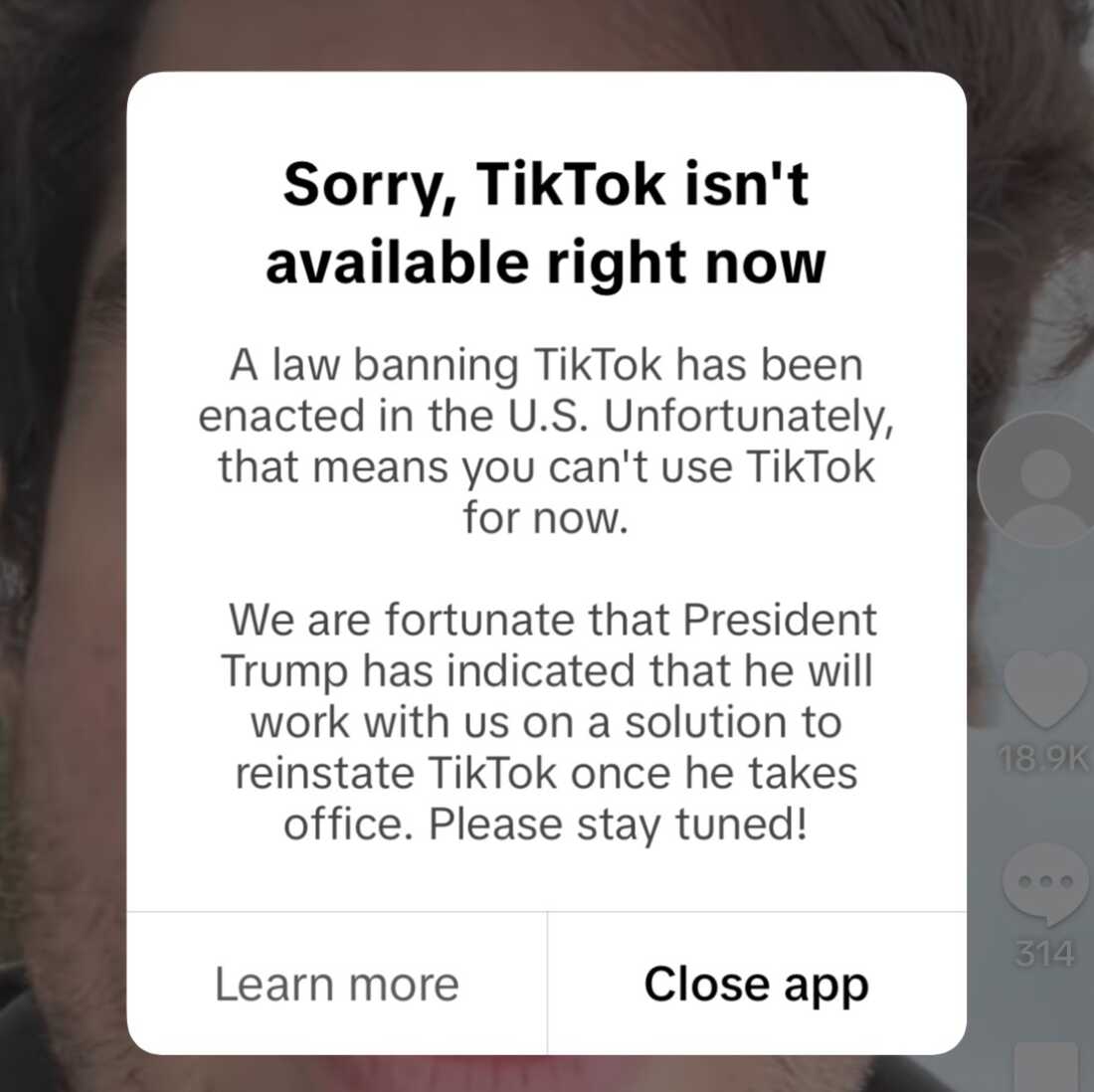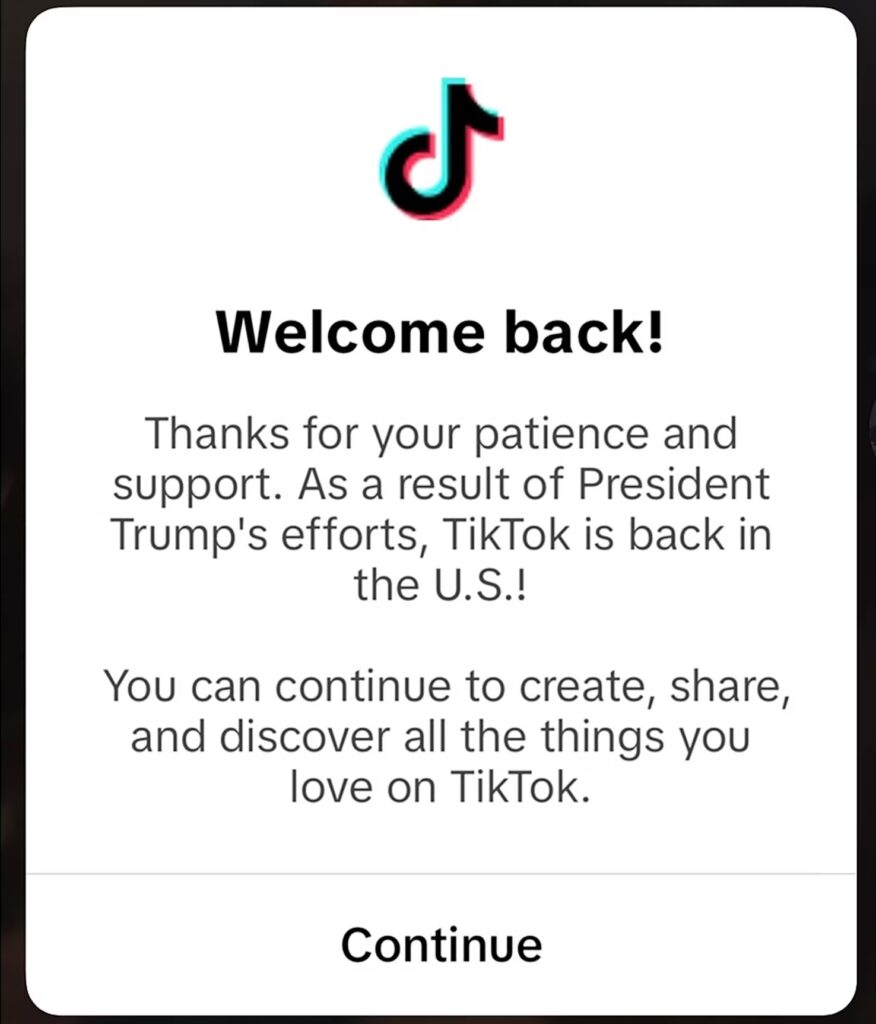
As TikTok still faces an uncertain future, publishers, advertisers, and creators brace for the ripple effects of a potential ban, exploring new platforms and strategies to maintain engagement.
For an excruciating 14 hours, consumers, content creators, and brands lamented TikTok’s loss. Many took to social media to memorialize the app, sharing screenshots of what they thought was the final message the clock app would send. The message read, “Sorry, TikTok isn’t available right now,” informing users that SCOTUS did not overturn the ban.
Yet, when many woke up the next morning, they could access the app. But before you could scroll, users received a welcome back message, including a thank you to President Trump. Suspicious stunts aside, users, creators, and brands had access to the app again.
On January 20, President Trump signed an executive order delaying enforcement of the law that would have banned TikTok, which granted a 75-day window to address national security concerns while preserving the app’s presence in the U.S.
TikTok plays a pivotal role in advertising budgets because of its massive reach. However, a December 2024 survey by Advertiser Perceptions found that 62% of advertisers viewed a U.S. ban as likely, prompting many to scale back or pause ad spend. TikTok’s growing dominance, evidenced by $4.8 billion in ad revenue in 2024, has made it a cornerstone for brands like Disney, Walmart, and Amazon, collectively accounting for $690 million of that spend.
If the ban proceeds, the ripple effects will be profound, forcing advertisers to reallocate budgets to platforms like YouTube and Meta. As the industry braces for the next chapter in the TikTok saga, questions remain about how brands and platforms will adapt to the new regulations.
1. Shifting Ad Dollars and Emerging Channels
If the ban continues after this 75-day pause, things will shake up advertising, at least for a little while, forcing brands to reevaluate their channel strategies. CTV and DOOH advertising emerge as promising alternatives, offering precision targeting and immersive experiences while providing greater stability and premium environments.
“The looming TikTok ban in the U.S. is set to disrupt the advertising landscape, particularly for brands that rely on the platform’s precision targeting. While ad dollars will likely shift to other social platforms, the real winner could be Connected TV (CTV). Already projected to outpace other channels in ad spend growth in 2025, CTV offers many of the same benefits advertisers love about TikTok: precise targeting, immersive creative formats, and measurable results. Given the anticipation of the TikTok ban, many brands have been preparing for this transition. But it’s not just the ban that will drive growth in CTV. Rising concerns about brand safety on other social platforms could make CTV an even more attractive alternative, offering a controlled, premium environment for advertisers.” – Jeremy Haft, CRO at Digital Remedy
“TikTok’s ad dollars will need to flow elsewhere. One area likely to benefit is Digital-Out-of-Home (DOOH) advertising. TikTok was highly effective at driving brand lift, not just performance, and DOOH is a channel with significant potential that has been underinvested in. With this ban, DOOH could become a key beneficiary of the redirected ad spend.” – Tal Jacobson, CEO at Perion
2. Short-Form Video Strategies in Flux
Brands are leveraging the TikTok ban to diversify their short-form video strategies. Platforms like Instagram Reels, YouTube Shorts, and emerging competitors are stepping in to capture the gap, with marketers focusing on adapting content for each platform’s unique strengths.
“The TikTok situation is forcing brands to rethink their short-form video strategies, but it’s actually pushing us toward a more resilient content model. While TikTok’s engagement rates are impressive – outperforming Reels by over 44% in comments – the real opportunity lies in how brands adapt their content across platforms. Rather than seeing this as a crisis, smart marketers are using it as a catalyst to build stronger, more diversified engagement strategies. The brands that will thrive are those that understand each platform’s unique strengths, whether that’s Instagram’s massive reach, Triller’s AI-powered tools, or Clapper’s community features.” – Calvin Scharffs, VP of Marketing at Orange 142
“If TikTok shuts down on Sunday, businesses, marketers, and users could face significant disruptions. With platforms like TikTok and Instagram now surpassing Google as the top search destinations for Gen Z – as highlighted by SOCi’s Consumer Behavior Index – marketers would lose a key channel for engaging younger audiences. Small businesses, which have relied on TikTok’s unique format to creatively promote products, will need to quickly pivot to alternatives.” – Damian Rollison, Director of Market Insights at SOCi
3. Music, Podcasts, and the Creator Economy
The ban will ripple through adjacent industries like podcasting, music streaming, and influencer marketing. Platforms like Instagram and YouTube could absorb much of the content that had previously thrived on TikTok.
“TikTok has been instrumental in podcast and music discovery for many users. This ban could have downstream effects on podcasting and music streaming, as viral clips or promotional content will likely shift to platforms like YouTube Shorts or Instagram Reels.” – Paul Kelly, CEO at AMA
“The Supreme Court’s deliberations on TikTok have the power to reshape the college athlete creator economy. With TikTok driving 22% of NIL deals and 40% of all social media engagements for athletes—numbers that have surged 73% year-over-year—marketers and athletes alike must prepare to adapt. A potential ban would force a seismic shift toward platforms like Instagram and YouTube, but with TikTok’s unmatched engagement (5% average follower interaction), maintaining ROI and audience connection will be the ultimate challenge.” – Bob Lynch, Founder and CEO of SponsorUnited
4. Resilience in the Face of Platform Volatility
The potential TikTok ban highlights the risks of over-reliance on any single platform, urging brands to prioritize independence, data ownership, and omnichannel strategies.
“Even with all of the back and forth over the last few days, the facts remain the same, TikTok must be sold if it is to continue to function in the US. However, this flip-flopping should be seen as a wake-up call for brands that rely heavily on social media platforms and other walled gardens. While these seem like safe and stable environments to invest spend and have vast amounts of data to benefit from, the events of the last few months should highlight the volatility and instability that lie beneath the surface.” – Nick Morgan, Founder and CEO, Vudoo
“Marketers must focus on building resilience by leveling up their in-house capabilities across data, identity, paid media, and creative. The key is owning your audience—having the ability to syndicate, distribute, and activate campaigns wherever consumer attention moves.” – Tim Smith, President, Axle Agency
5. Opportunities in Live Shopping and Contextual Targeting
With TikTok’s exit from social shopping, brands are rethinking live shopping strategies and embracing platforms that offer data privacy and contextual targeting to ensure sustainable growth.
“While TikTok’s brief exit as a social shopping player created uncertainty, it serves as a strong reminder that brands and sellers can’t rely solely on third-party platforms, as the landscape can shift unexpectedly. This highlights an opportunity for brands to rethink their live shopping strategy—whether that means leveraging other digital marketplaces like CommentSold, Poshmark, or Whatnot, or taking control by integrating live shopping into their own apps or websites.” – Andrew Thompson, VP of Sales at Agora
“Advertisers will need to swiftly migrate their TikTok campaigns as the ban is implemented. We’re already in discussions with some of the world’s largest brands and agencies about shifting their budgets to alternative channels on the open web. This focus on data privacy has also highlighted the importance of investing in non-invasive ad platforms that emphasize contextual targeting.” – Kerel Cooper, CMO of GumGum
Future-Proofing Marketing: Innovation in the Wake of the TikTok Ban
As the industry grapples with the implications of another potential TikTok ban, it’s clear that this moment is a wake-up call for marketers to reevaluate their strategies, prioritize resilience, and lean into innovation.
Tim Smith aptly notes, “The ban is yet another reminder of the risks of over-reliance on walled gardens, which often prioritize convenience over transparency and autonomy.” By investing in their own data and identity systems, marketers can future-proof their efforts and engage audiences wherever they migrate, avoiding the disruptions caused by over-dependence on single platforms.
At the same time, voices like Brendan Greene’s, North America Lead, Ad Operations at TikTok, remind us of the human impact of these changes—the thousands of employees who have built TikTok into a dynamic platform that has transformed how we connect, learn, and engage. Furthermore, it helped publishers and advertisers connect with their audiences.
As we move forward, it’s essential to balance strategic pivots with recognition of the talent and innovation that drive this industry, ensuring that agility and empathy guide us through the challenges ahead.

